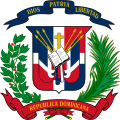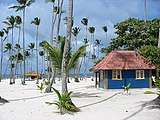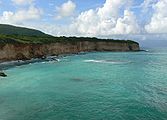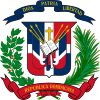Portal:Dominican Republic
Introduction
The Dominican Republic is a North American country located on the island of Hispaniola in the Greater Antilles of the Caribbean Sea in the North Atlantic Ocean. It shares a maritime border with Puerto Rico to the east and a land border with Haiti to the west, occupying the eastern five-eighths of Hispaniola which, along with Saint Martin, is one of only two islands in the Caribbean shared by two sovereign states. In the Antilles, the country is the second-largest nation by area after Cuba at 48,671 square kilometers (18,792 sq mi) and second-largest by population after Haiti with approximately 11.4 million people in 2024, of whom 3.6 million reside in the metropolitan area of Santo Domingo, the capital city. The Dominican Republic has the largest economy in the Caribbean and the seventh-largest in Latin America. Over the last 25 years, the Dominican Republic has had the fastest-growing economy in the Western Hemisphere – with an average real GDP growth rate of 5.3% between 1992 and 2018. GDP growth in 2014 and 2015 reached 7.3 and 7.0%, respectively, the highest in the Western Hemisphere. Recent growth has been driven by construction, manufacturing, tourism, and mining. The country is the site of the third largest (in terms of production) gold mine in the world, the Pueblo Viejo mine. The Dominican Republic is the most visited destination in the Caribbean. A geographically diverse nation, the Dominican Republic is home to both the Caribbean's tallest mountain peak, Pico Duarte, and the Caribbean's largest lake and lowest point, Lake Enriquillo. The island has an average temperature of 26 °C (78.8 °F) and great climatic and biological diversity. The country is also the site of the first cathedral, castle, monastery, and fortress built in the Americas, located in Santo Domingo's Colonial Zone, a World Heritage Site. (Full article...) Selected article - The Dominican Restoration War or the Dominican War of Restoration (Spanish: Guerra de la Restauración, Guerra de Santo Domingo) was a guerrilla war between 1863 and 1865 in the Dominican Republic between nationalists and Spain, the latter of which had recolonized the country 17 years after its independence. The war resulted in the restoration of Dominican sovereignty, the withdrawal of Spanish forces, the separation of the Captaincy General of Santo Domingo from Spain, and the establishment of a second republic in the Dominican Republic. During the period of the First Dominican Republic, the nation endured repeated attacks from Haiti, and annexation attempts from France, Spain, Great Britain, and the United States, all of which threatened national sovereignty. Also posing a threat to the nation was the dictatorial ways of the presidents who during those years alternated in power. Pedro Santana and Buenaventura Báez were the two prolific politicians competing during this time. At the end of his last term, Pedro Santana decided to annex the country to Spain; His idea was to end the permanent threats from Haiti, but also to remain in power, since in exchange he accepted the position of captain general of the new Spanish province of Santo Domingo. (Full article...) General images -The following are images from various Dominican Republic-related articles on Wikipedia.
Selected picture -An aerial view of the Punta Cana International Airport
Selected biography -Pedro Santana y Familias, 1st Marquess of Las Carreras (29 June 1801 – 14 June 1864) was a military commander and royalist politician who served as the president of the junta that had established the First Dominican Republic, a precursor to the position of the President of the Dominican Republic, and as the first President of the republic in the modern line of succession. A traditional royalist who was fond of the Monarchy of Spain and the Spanish Empire, he ruled as a governor-general, but effectively as an authoritarian dictator. During his life he enjoyed the title of "Libertador de la Patria." Aside from Juan Sánchez Ramírez, he was the only other Dominican head of state to serve as a governor to Santo Domingo. He was one for the signatories of the Manifesto of January 16, 1844 and proclaim Dominican independence on February 27, 1844. He would assume the leadership of the expeditionary army of the southern border and quickly gain military prominence for his victory in the Battle of Azua. He led a coup d'état against the Central Governing Board and was named its president on a provisional basis. During his government, the first constitution of the State would be promulgated, and he would be designated as the first constitutional president of the Dominican Republic. Finally, in 1848, Santana presented his resignation, despite the opposition of Congress. Internal political intrigues and popular discontent played an important role in his decision. (Full article...) Related portalsWikiProjects
Things to do
Associated WikimediaThe following Wikimedia Foundation sister projects provide more on this subject:
SourcesDiscover Wikipedia using portals | |||||||||||||||||||||||||


















































































